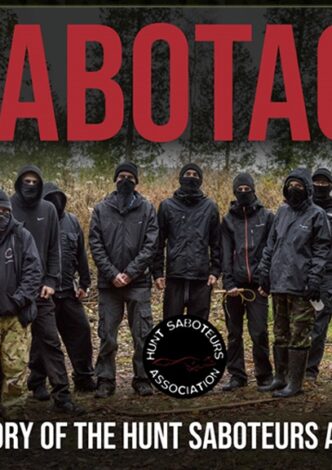Book Review: Dazza Scott, Sabotage: The Story of the Hunt Saboteurs Association (Hunt Saboteurs Association, 2021).
In 2023 the Hunt Saboteurs Association will mark its 60th anniversary. Sabotage shows that it has plenty to celebrate. For all the horrors, joys, tears, and moments of farce brought to life in this book, the hold of bloodsports is much diminished since the organisation was founded in 1963. There is a long tradition of opposition to fox hunting and other cruel sports, an expression of the default entitlement of the landowning class to dominate rural life. Henry Salt’s Humanitarian League was a notable early forerunner in the late nineteenth century. The HSA began as one of the pioneering grassroots direct-action movements that emerged during the 1960s, Its prototypes were, perhaps, civil disobedience groups such as the Direct Action Committee and Committee of 100, which undertook extra-parliamentary action against nuclear weapons from the late 1950s. It is certainly time for a history of the HSA. Yet an important part of the story is of the shortcomings of the 2004 Hunting Act, which has ensured that hunt saboteurs cannot yet retire, and must continue to take to the fields. The continuation of fox hunting under the guise of so-called trail hunting, in particular, left a legal loophole large enough to drive a kennel van and horses through the legislation.
The West Country was at the heart of much of the action and continues to be so to the present day. We learn that the HSA’s founder, 21-year-old John Prestige organised the first outing against the South Devon Hunt near Torquay in 1963. Hits targeting the Devon and Somerset Staghounds followed in early 1964. Joyce Cebo who founded Street HSA, also in 1964, could boast an impressive 40 members by the end of that year. In Bristol, Ian Pedlar revitalised the “moribund” League Against Cruel Sports group in the city and transformed it into the HSA group that continues (p. 6) as does the Bath group which also began in the mid-1960s. The tactics of the art and science of hunt sabotage have been effective. Unfortunately, sabs have had to defend themselves against violence from hunt members and their supporters from the outset. It has been a life and death struggle, resulting it should never be forgotten, in the tragic deaths of two young sabs, Mike Hill (1991) and Tom Worby (1993), killed by members of the hunt, as well as the animals that are the “quarry” of bloody entertainments, and the hundreds of hounds that are “dispatched” early.
The author Dazza Scott and HSA researchers have done excellent archival work in seeking out and curating primary materials to create a comprehensive text about confronting hunt cruelty in the fields, woods, and rivers over six decades. An impressive collection of photographs dates back from the campaigns of the early 1960s to the present day. While Sabotage has the appearance and format of a coffee table book, with its multiple full page cover colour images, it is certainly a coffee table with a difference. This book smells of citronella and garlic spray, of petrichor and diesel. It evokes the sounds of horn blowing on frosty mornings baying of the hounds and slanging matches between the pros and antis. And it feels visceral.
A fascinating and relevant part of the history of hunt sabotage is the war of liberatory espionage, infiltration, and police collusion. As much bloodsport activity has been put on the defensive and driven underground, sabs have increasingly relied upon local knowledge and tip offs to find meets and monitor trail hunting. National police coordination against hunt sabotage was formalised with the creation of the Animal Rights National Index (p. 75) during the late 1980s. Hunt sabotage has endured in the face of newspaper campaigns against “animal lib fanatics” and Tory legislation, such as clauses in the Public Order Act 1986 and the Criminal Justice and Public Order Act 1994. Despite the 2004 Hunting Act, police attention continued to be focussed upon hunt sabs and monitors rather than the perpetrators of cruelty in contravention of the legislation. In 2020, the HSA made available notorious leaked online training sessions by the Hunting Office that confirmed persistent allegations of political and police bias. The release of the webinars, organised by fox hunting’s governing body and chaired by Conservative peer Lord Mancroft, exposed senior members of the hunt advising on how to break the law, with a retired police officer and hunt member recommending the use of burner phones to avoid prosecution (p. 180). Mark Hankinson, the Director of the Masters of Foxhounds Association was found guilty following the revelations.
As a post-script, even since the publication of Sabotage there has been a further major local debacle as supporters of the Avon Vale Hunt attacked protesters in Lacock, Wiltshire on Boxing Day 2021. The lack of intervention from the two onlooking police officers present contrasted markedly to the multiple police vehicles that are allegedly regularly sent out to work alongside the same hunt against local protesters. After the fracas at Lacock, it was soon revealed that one of the two officers on duty to police the event, was herself a rider with the Avon Vale Hunt. However, Wiltshire Constabulary were, of course, quick to “reassure” local people that there was no conflict of interest.
Sabotage concludes that “The resilience, determination and tireless work by hunt saboteurs over more than 50 years is truly remarkable.”
Hats off to the hunt sabs!
Buy Sabotage: The Story of the Hunt Saboteurs Association direct from the Hunt Saboteurs Association: https://www.huntsabs.org.uk/product/sabotage-the-story-of-the-hunt-saboteurs-association/ (£25).
